PrAACtically Reading with Brown Bear
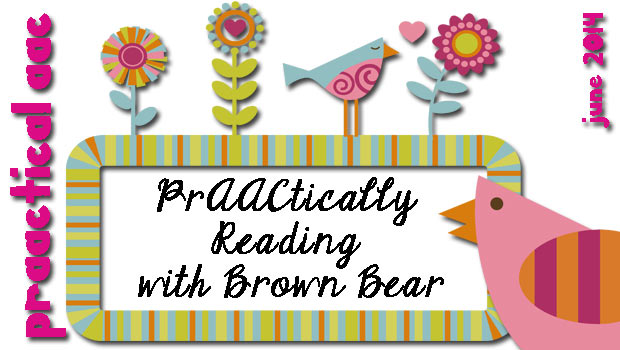
There are so many wonderful things about reading with kids, and practicing AAC is one of them. Every month, we’ll try to pick a book and provide some prAACtical suggestions for how to read it and sneak in some opportunities for receptive and expressive AAC use.
You can make book-specific screens, overlays, or boards, but we favor a more powerful approach: use core vocabulary as your base and supplement with words specific to that book. Need some core language displays? There are many floating around, but here’s a link to ours if you need some more.
We thought we’d start off this series with a book that is familiar to most, if not all, of you. Pull it off your shelf, find your prAACtical pal, grab that core language board, get to a cozy spot, and let’s get started.
PrAACtically Reading with Brown Bear
Brown Bear, Brown Bear, What Do You See? by Bill Martin, Jr. and Eric Carle is so well known for its repeated lines that professionals working in preschools have been known to recite it in their sleep. That’s good for literacy learning, and fantastic for AAC practice, as well. If the goal is primarily participation in the story reading activity, the repeated line can be recorded onto a talking switch, single message AAC app (such as TapSpeak Button), or talking photo album app.
However, if we’re doing this to teach language then we want to stretch ourselves a bit more. Luckily, the repeated lines in this story are loaded with core words. You can use “I see” or “What do you see?” on almost every page. Those can certainly be recorded on single message devices or put together word by word. Just getting started in using the pivotal strategy of aided language input? Get some prAACtice by using saying those things on many of the pages.
Here are some other ideas for aided language input and language elicitation focusing on core vocabulary.
- Again
- All (the animals/children)
- Big (bear)
- Different (animal)
- That (animal)
- This (bear)
- Where?
- I know.
- It (is) not (animal)
- What (is) it?
- He go away.
- He see(s) it.
- He see(s) more.
- I need help.
- You know it.
We can get lots of mileage using core words when we retell the story later on, too. It’s helpful to use story images, such as these, to keep the little ones engaged. The wonderful team at Miami Dade PreK ESE Program shares PCS symbols for Brown Bear here.
Need some ideas for extension activities?
- A Mini Book for practicing 2-word sentences by Jill Van Winkle
- Extension activities by Lisa Bailey
Looking for other AAC resources that have book-related vocabulary? These AAC materials from Baltimore City Public Schools and these on Boardmaker Achieve (Thanks, Kathy B!) may be helpful.
Do you have ways of making Brown Bear a fun and effective AAC learning experience? We’d love it if you’d share some of your ideas in the comments below. Let’s collaborate!
Edited: Check out these Boardmaker files from the amazing folks at Loudoun County Public Schools. (Thanks, Judy and Sally!)
Filed under: PrAACtical Thinking
Tagged With: Brown Bear, core vocabulary, literacy, reading
This post was written by Carole Zangari

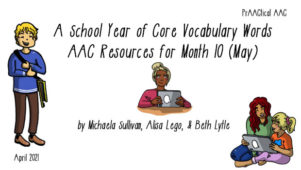
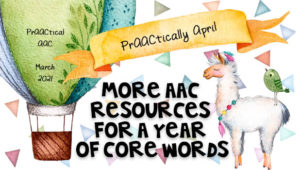
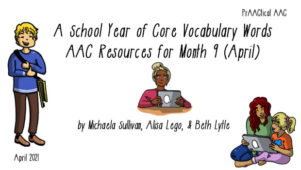
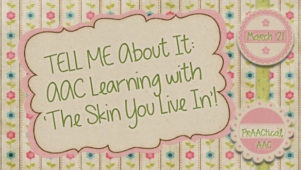
6 Comments
The link for “Mini Book for practicing 2-word sentences” is broken!
Thanks for letting us know, Kate. Should be working now. 🙂
Please check out the Loudoun County Assistive Technology Team’s AT website. Sally Norton-Darr and Judith Schoonover have put together resources for adapting books, including our favorite Brown Bear got to bit.ly/adaptbooks!
Ooh! Those resources look terrific, Judy! Thanks for sharing them here!!
Thank you for this lovely post. I enjoy sharing this book with students and your suggestions for core vocabulary using AAC while reading Brown Bear are very helpful. For children who are responsive to song, I also use this video:
https://www.youtube.com/watch?v=ek7j3huAApc
Warm Regards,
Lindsay Oesch
Thanks for that suggestion, Lindsay! I am always looking for ways to integrate music as so many of my little friends really enjoy it. Off to check out the video! Thank you for taking the time to share it with us. 🙂